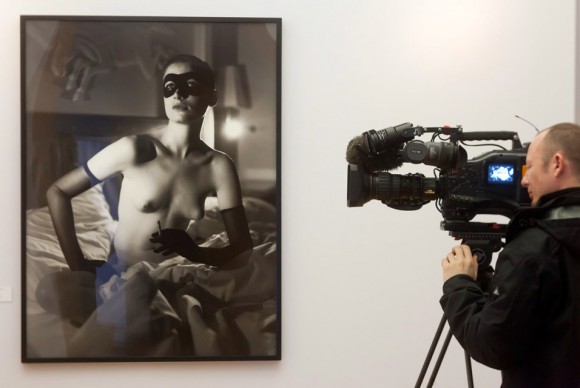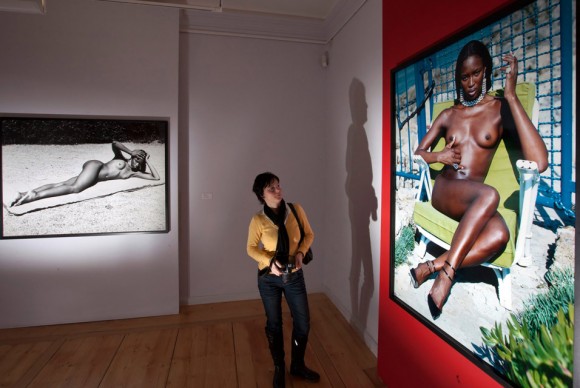Exhibition of Photographs by Helmut Newton on View at the Kunsthaus Apolda Avant-Garde
January 10, 2011 by All Art News
Filed under Featured, Photography
APOLDA.- The road here was long. “For years we had the desire at some point to have a Newton-exhibition in Apolda “, said on Friday Hans Jurgen Giese, Managing Director of the Kunstverein Apolda Avant-Garde.
“In mid-2008 I asked the Newton Foundation to bring works of the legendary photographer to the Kunsthaus Apolda. The answer was at that time sobering: It was said that the images would only be shown in major cities, not in the province”.
The exhibition includes 75 images from the 1973 to 2002. Among the works are large-format black-and-white and color photographs, featuring such stars as model Naomi Campbell. The exhibition also shows Polaroid series from the collection of fashion designer Yves St. Laurent. Newton fetish performances and images of women in glamorous surroundings are also part of the show.
Helmut Newton became an icon by creating icons. He photographed for Vogue ‘and the biggest fashion magazines in the world. With his book, Helmut Newton with his style of fashion photography – and the aura of the super models – shaped, what today has become an iconographic part of our reality. The untouchability of its models, which despite – or perhaps because of – their nakedness appear inviolable and unapproachable, and an influenced aesthetic that is reflected in every detail, have been enrolled in the visual language of our present. Helmut Newton was instrumental in that, glamour photography was a central expression of an era.
Born Helmut Neustädter in 1920 to a well-to-do Berlin family and interested in photography early on, Newton purchased his first camera at 12 and as a teenager apprenticed with noted German theatrical photographer Yva (Else Simon, who later perished at Auschwitz). The passing of the anti-Semitic Nuremberg Laws in 1935 drastically worsened his family´s situation, however, as his father lost control of his factory and was briefly interned in a concentration camp. The Kristallnacht attacks of November 1938 forced Newton´s parents to flee to Chile; the 18-year-old Newton traveled alone to Singapore.
In the fall of 1940 Newton´s life took another radical turn: he was interned by British authorities as an “enemy alien,” shipped to Australia, and placed in a camp from 1940 to 1942. He was released to serve in the Australian Army until the end of the war, gaining Australian citizenship in 1945 and changing his name to Newton. Finally a free agent, he opened a photography studio in Melbourne and met his wife, June Browne, an actress who posed for him. She went on to play an integral role in Newton´s career: she modeled for him, curated his exhibitions, and edited his books (including the three publications the MFAH exhibition is based on). She also became a photographer herself, shooting under the pseudonym Alice Springs.

A cameraman films a photograph, entitled Grand Hotel et de Milan,by Helmut Newton, on display at the Kunsthaus Apolda Avantgarde in Apolda, Germany, 07 November 2011
The couple traveled Europe and Australia during the 1950s, when Newton shot for British and Australian Vogue, and settled in 1961 in Paris, where Newton joined French Vogue. As American Vogue editor Anna Wintour states in the exhibition catalogue, Newton´s work went on to be “synonymous with Vogue at its most glamorous and mythic.” With top photographers Horst P. Horst, Irving Penn, Herb Ritts, and Richard Avedon, Newton transformed fashion photography from a mere photographic report of current styles to an alluring presentation with mis-en-scene and a narrative. In addition to his magazine work, Newton was also much sought-after for commissions by a variety of institutions, from fashion houses and jewelry designers to car manufacturers. In many cases, Newton would be on a professional shoot and adjust the shots to become more sexually suggestive, adding these second “takes” to his personal body of work.
By the end of his life Newton had received many awards, including the Grand Prix National de la Ville de Paris and Commander in the Order of Arts and Letters. In 2000, the Neue Nationalgalerie, Berlin, held a major retrospective for Newton on the occasion of his 80th birthday—also organized by Heiting—and the show traveled to London, New York, Tokyo, Moscow, and Prague, and other cities. Three years later, in 2003, the Helmut Newton Foundation was established in Berlin. At the height of his success, the artist and his wife lived in Monte Carlo but wintered in Hollywood at the famed Chateau Marmont Hotel.
Newton died in January 2004 at 83. His final magazine spread was published posthumously in the March 2004 edition of Vogue.

